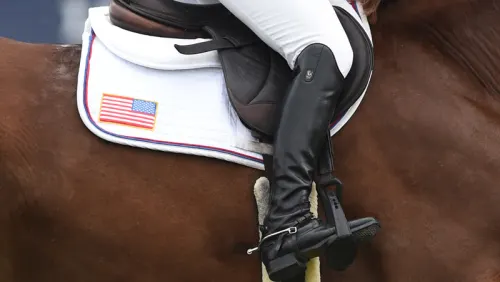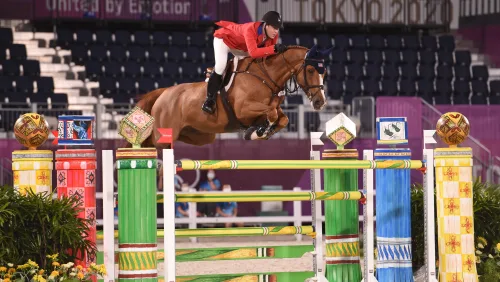There aren’t many horses who could handle 120 days of stall rest with only “love and attention” to ease the stress of confinement. But Jamie Bice wasn’t surprised her mare Kilfarissey Angel didn’t need sedation to cope with four months of confinement as she recovered from a spinal injury. “Angel” is, if not an actual angel, an especially sensible horse who turned out to be as stellar a patient as she is an athlete.
In October 2019, Bice got a call that something wasn’t right with her jumper. Bice, who owns and runs Jaid Stables in Canton, Georgia, would regularly turn out the Irish Sport Horse (Waldo Van Dungen—Liosin Lux, Olympic Lux) in a field next to a wooded area. On that day, Angel surprised staff by suddenly appearing outside her pasture and walking herself up to the barn. It seemed as though she was asking the humans for help, Bice said.
“She was kind of wobbly, and her head was a little sideways,” Bice said. “I immediately called my vet. My vet rushed over and noticed right away that she had broken her face right in between her eyes almost. She had suspected that [Angel] probably broke her neck because of the way she was holding her head—she was real pitiful looking.”
The worried owner brought her mare to Auburn University’s John Thomas Vaughan Large Animal Teaching Hospital (Alabama) to evaluate Angel’s injuries in a standing CT scan.
“[The scan] showed us that she had broken a portion of her C2 and C3 vertebrae,” Bice said. “Thankfully, where it was, she had an OK prognosis, as long as she wanted to get better—as long as she would stay calm and still.”
The Auburn veterinary team told Bice that if Angel could make it through those first 120 days, then she had a pretty good chance of survival. However, it was still too early to know exactly what level of work Angel would be able to return to. Bice had imported the then 11-year-old mare from Ireland a few years earlier, following years of saving and an intensive shopping trip where Bice had tried more than 50 horses. Now Angel’s injury, and her restrictive recovery, left their future uncertain.
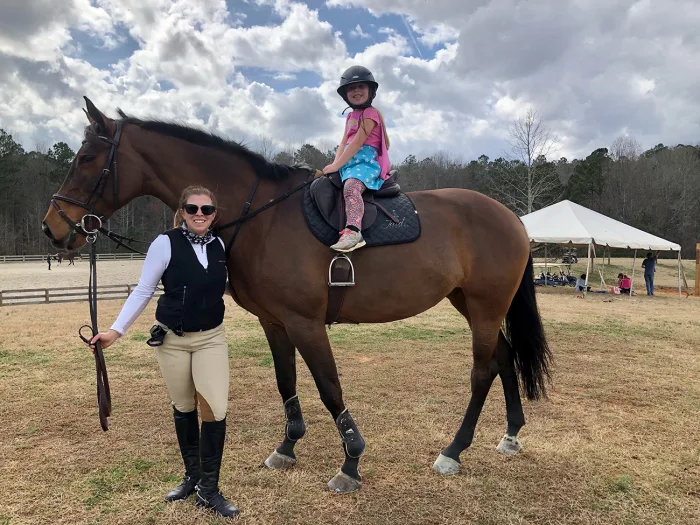
“It was very heartbreaking because this was my dream horse,” Bice said. “My husband and I had saved for years and years and years. I worked really hard as a young professional and as an amateur to be able to have a horse like this. We were just starting our 1.30-meters and doing well. It was just very heartbreaking to possibly have that all ripped away from me in a matter of moments.”
A Slow And Steady Path To Recovery
While no one witnessed Angel’s accident, Bice and her crew returned to the pasture to make sense of how the quiet scene could have led to such a severe injury. Noticing a crack in the top fence board and disrupted leaves by a nearby tree, they theorized Angel may have been attacked by stinging insects, causing the typically reasonable—not to mention scopey—mare to jump out of her pasture to escape. It looked like she might have hit the fence, fallen and collided with a tree.
The circumstances of her accident were murky, but the instructions for her recovery were absolute: Angel could not leave her stall. Any exercise or erratic movement could jeopardize her recovery. Even eating at a certain angle might agitate her fractures, so she was fed and watered at chest level. Her facial injury, although alarming in appearance, was the least of her problems and was left alone to heal.
Angel endured those critical 120 days, with frequent visits from Bice, her husband David and the couple’s then 6-year-old daughter, Layla. Angel, a gentle giant at almost 18 hands, seemed to enjoy the special attention from humans. Her regular veterinarian, Dr. Jennifer Melcher, DVM, of Thompson and Associates Equine Medicine, helped Bice develop a roadmap to get the mare back to her old, active self. Following her lengthy stall rest, they returned to Auburn for radiographs to see how her injuries had healed.
“We took her back and had her reevaluated at the university just to be 100% sure things looked like they healed as far as they could,” Melcher said. “They felt like at that point we were good to go, and that it had healed, and there wasn’t a lot of displacement fracture lines. Then it was on us to come up with a rehab plan.”
Finally out of the woods, Angel was cleared to begin a regimen of hand walking. Bice built up her horse’s daily exercise from simple walks, to hill work, to trot sessions in hand. She would vary the setting of these sessions between the fields and arena to keep it “visually entertaining” for the mare, who had only seen her stall walls for months.
ADVERTISEMENT
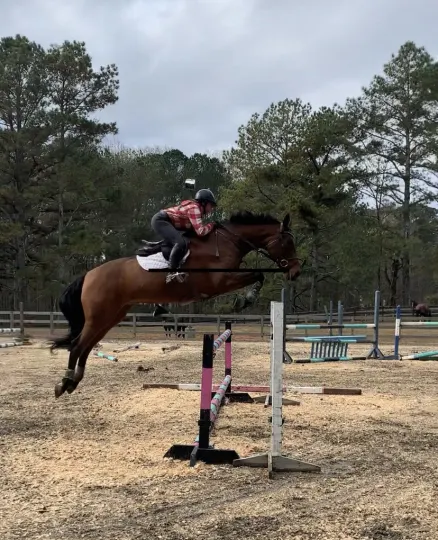
Bice and her veterinary team were focused on rehabilitating Angel slowly. If they rushed, Melcher was concerned that she could develop arthritic changes or permanently compromise her range of motion.
“We probably walked for at least a month, and then started integrating some trot work,” Bice said. “We would try just the straightaways a couple times, and then most of the time we’d walk, and then slowly we worked up to trotting the straightaways. Then eventually, we started being able to try a very gradual curve.”
Bice regularly consulted with Melcher, updating her veterinary team about the mare’s progress to decide what they could add or where they should slow down her physical therapy.
“Her range of motion had decreased clearly, as you could imagine,” Melcher said. “They really need to use their heads and necks to jump, and that was her career: to jump. So Jamie really put the time and diligence into appropriately working back to range of motion with the neck, and slowly helping the horse to redevelop that ability to move the neck the way she needed to.”
Melcher and Bice left no stone unturned, integrating an Equicore system, a trigger gun release tool, chiropractic work and carrot stretches into her routine. Bice’s first time back in the saddle was monumental for her, if technically uneventful.
“It was probably the best feeling ever, even though we just walked,” Bice said. “It was very encouraging—a little bit nerve wracking, but Angel was very good. You could tell that she was excited that we were doing something other than hand walking, but she didn’t do anything bad. You could tell she was like, ‘Oh, I’m getting back, and I like this. This is good.’ ”
Because of all the physical therapy that went into developing Angel’s fitness correctly, Bice was delighted that the mare felt stronger under saddle than she had expected.
“When I could ride her, she actually felt pretty strong through her topline, and her haunches felt strong; her neck was weak, but understandable,” Bice said. “But the rest of her body felt pretty strong, which was a really cool feeling, because I was really concerned about getting on this weak horse.”
As their riding progressed, Bice reintroduced jumping, beginning with trot poles and gradually working up to a crossrail.
“It was about six months before I jumped her for the first time again,” Bice said. “And it was obviously just a small crossrail that time. She was very, very excited about that.”
Bice and Melcher’s rule all along has been to let Angel tell them what she’s ready for. When Bice got Angel back into lower-level show jumping, the mare seemed happy to be there. But when the jumps went up, Bice noticed a change in her mare.
“I didn’t feel her competitiveness come back until probably about the meter,” Bice said. “When we started doing the meters again, that’s when I felt like she really wanted to be competitive. Up until that point, I felt like she was jumping and having fun.”
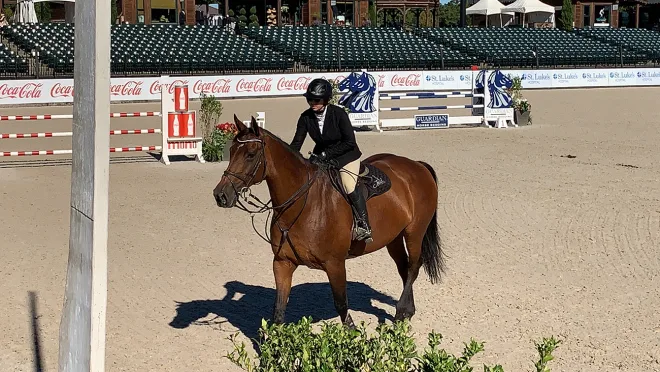
In August, Bice entered Angel, now 15, in a competition that she felt solidified her horse’s comeback. At the Wills Park Equestrian Foundation Benefit Horse Show in Alpharetta, Georgia, the pair had a strong performance in the $10,000 1.25-meter mini prix.
ADVERTISEMENT
“There were 20 riders, and we ended up fifth, and she was double clear,” Bice said. “She jumped amazing and was just the perfect partner anybody could ask for.”
Angel has come a long way since she entered the barn with a fractured face and cracked vertebrae. Bice’s methodical approach to her horse’s recovery has been key to getting her back into her job as fit and happy as ever. Bice and her veterinary team curated a rehabilitation plan that focused on the whole horse, not just the injury.
“Part of what we really tried to do with her rehab plan was not just focus on the neck but on the whole body, so that she could compensate and keep herself strong in her base, in her core,” Melcher said. “In keeping her strong, it doesn’t put all the pressure in one spot.”
Angel’s healing didn’t just require time off—it required her people to put time into the horse. Melcher says that while many concerned owners want to keep their injured horses “in a box and never move them,” proper movement is essential to bringing a horse back. Bice was meticulous about following through on the care plan.
“By miracle, and effort, and all the rehab that she did—and I think it’s somewhat luck in how the fracture occurred—she’s been able to go back and do the job,” Melcher said.
Looking To The Future
Before Angel’s injury, Bice knew that she had met her dream horse. Angel’s demeanor during her recovery only reinforced that the mare was also Bice’s heart horse. Now that Bice is living out the partnership she’d hoped for with Angel, she’s able to think even further ahead. Last year, Bice decided she’d like a foal from her beloved mare, and they bred her using an embryo transfer so Bice and Angel didn’t have to take any more time off riding and showing.
Bice can see bits of Angel in the mare’s 4-month-old filly, Sky, who has inherited some of the qualities that made her mother’s rehab so smooth. She said Sky is already cuddly and a big fan of human attention. The filly and the recipient mare currently neighbor Angel’s stall.
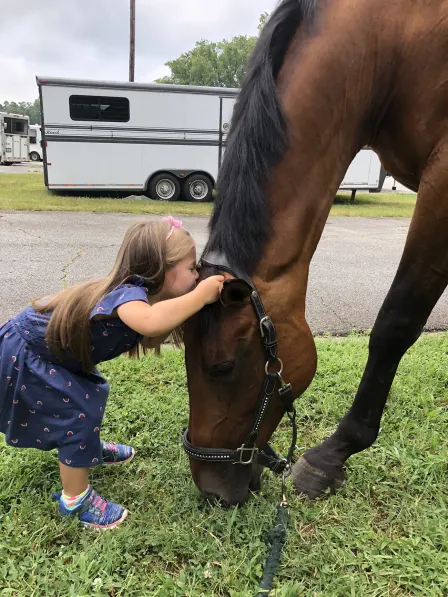
Bice predicts that her own daughter, Layla, who bonded with Angel during her long stall rest, may one day graduate to riding her mother’s beloved jumper. Already, Layla has spent some time in the saddle atop the gentle giant.
“Once Angel tells me she doesn’t want to do the bigger jumps or bigger classes anymore, then eventually my daughter will learn the jumper ropes on her, I’m sure,” Bice said.
As far as Bice is concerned, her horse of a lifetime has a home for life.
Do you know a horse or rider who returned to the competition ring after what should have been a life-threatening or career-ending injury or illness? Email Kimberly at kloushin@coth.com with their story.






